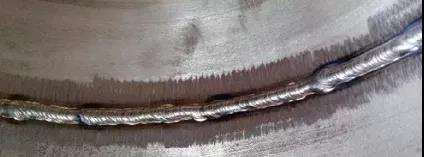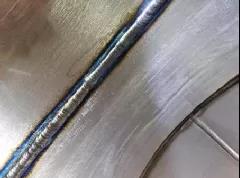Petrochemical construction, stainless steel pipe in welding, and heat affected zone of weld bead color easy oxidation, in order to guarantee the corrosion resistance of stainless steel, pickling passivation treatment was carried out on the weld after welding, make its surface to form a layer of dense oxide film, but the lining of the stainless steel pipe and often cannot pickling passivation, severely reduces the stainless steel pipe wall corrosion resistance. However, it is difficult to guarantee the welding quality of back beadand heat-affected zone with general welding process and construction measures (see Fig. 1 and Fig. 2), so it is necessary to improve the welding process and take measures to prevent back oxidation and discoloration.

 Reason analysis of easy oxidation on the back and surface of stainless steel pipe welding.
Reason analysis of easy oxidation on the back and surface of stainless steel pipe welding.
1) When the back is protected by argon, the air in the tube is always swirling and difficult to be completely discharged. Even if the replacement time is extended, the oxygen content can reach < 0.01% (volume fraction) when the inner mouth is fully sealed. However, after opening the groove and starting welding, the oxygen content will rise to 0.05% (volume fraction) or even higher.The higher oxygen content eventually causes the surface of the bead back to oxidize and turn blue or purple.
2) In the field construction, the welder generally uses the simple argon arc welding gun which is used to brush and start the arc. This kind of welding gun loses the protection of argon gas at high temperature after the welding arc is broken, which leads to the oxidation and discoloration of the joint of arc closing each time.
3) Every time the arc joint starts, because the air enters the inner mouth through the open welding groove, the oxygen content in the inner mouth is high at this time, and the weld pass at high temperature is easy to be locally oxidized.
4) In the filling and cover layer welding, the welding current is large, the welding heat input is large, or the temperature between layers is high, the back of the weld pass will also be oxidized and discolored.
5) Argon gas with low purity and high oxygen content has poor protective effect on welding seams.
6) stainless steel thermal conductivity is poor, 1/3 of the steel, in the welding heat does not go out, leading to the weld pass and heat affected zone temperature is higher, so it is easier to be oxidized.
Welding process improvement
1)The oxygen in the inner shield gas is the main reason for the oxidation discoloration of the weld pass and the heat affected zone, so the oxygen in the shield gas can be eliminated to solve the oxidation problem.After the improved process, high purity argon with 99.999% purity is used as welding gas, mixed gas (5%H2+95%Ar) is used as the back protection gas, and the chemical reaction of hydrogen and oxygen at high temperature is used to reduce the oxygen content in the tube.
2) Argon gas has a higher density than air. When replacing the air in the tube, the principle of low charge and high discharge shall be adopted, and the replacement time of charging shall be appropriately extended.
3) Use welding machine and high frequency arc gun with current slow rise, current attenuation, advance air supply, lag stop qigong energy.When the arc is just started, the oxygen in the protective gas is burned by the burning arc first, so as to avoid the oxidation of the welding pass when the arc is started. After the arc is broken, the welding pass with high temperature is still under the effective protection of argon gas, so as to prevent the local oxidation and discoloration of the joint.
4) Increase the nozzle diameter, using Φ10 ~ Φ12mm nozzle, increase the protection range.
5) Tin-foil tape with good sealing performance is used for groove sealing, instead of paper tape.
6) When the final joint is closed, reduce the flow rate filled with argon. It is better to use the method with the flow rate filled with argon unchanged while one side opens the exhaust for the best welding effect.
7) The temperature between the weld and the layer is not more than 60℃. In welding, cooling copper pipes with circulating water are wound on both sides of the weld or wet cotton cloth is wrapped around both sides of the weld to reduce the high temperature residence time of the weld.

 Reason analysis of easy oxidation on the back and surface of stainless steel pipe welding.
Reason analysis of easy oxidation on the back and surface of stainless steel pipe welding.